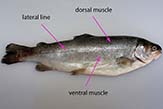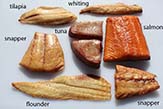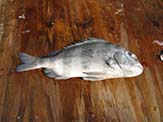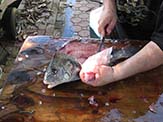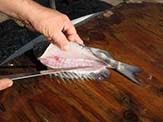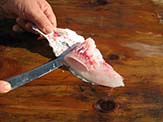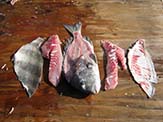Meats and Sausages
Filleting Fish
The main part of the flesh of a fish constitute the body muscles, two dorsal and two ventral muscles on each side separated from one another by strong connective tissue along the lateral line.
Remember that the ventral muscle is covering the rib cage in the front of the fish and is much thinner there. It becomes thicker again as it passes the vent towards the tail. Some sources recommend removing scales, others ask to leave them on. Scales act as a tough barrier and removing scales provides the following benefits:
- Faster salt penetration during brining.
- Faster smoke penetration.
- The product develops better gloss and looks more appealing.
Use only meaty fish for filleting. Supermarkets sell frozen fish fillets but they are often packaged in a way that prevents seeing the contents. The bag that weighs one pound may contain many thin fillets. Keep in mind that a fillet will lose a lot of moisture during smoking and cooking. A thin fillet will become so thin after smoking that it may be difficult to handle.
You can leave the skin on fat fish like mullet, salmon, mackerel, trout, eel or bluefish. Fat fish have substantial amount of fat under their skins and this skin can be easily peeled of after smoking. The skin of lean fish such as cod, whiting, flounder, tilapia will adhere to the flesh very tightly after smoking and will be hard to remove. Make sure that the screen is oiled to prevent fillets from sticking. A lighter-flavored fillet can be produced by deep skinning the fish and discarding the underside layer of the skin. The disadvantage is that even a skilled operator must throw away a lot of usable meat that is located around the backbone.
Sheepshead also known as the “convict” fish is often caught along with mullet. The filleting procedure for both fish is the same, however, sheepshead fillets are thicker.

